Last updated on 6 April 2025
Please note if you are using DSM7.2 or higher you should use the Container Manager version of this guide from the menu.
This guide has reached the end of its updates as most people are now on the latest DSM update - This guide is correct as of 08/12/2023 however no further updates will be added.
| Update | Date |
|---|---|
| Removed docker compose section as rarely used | 18/07/2023 |
What is Readarr?
Readarr is an e-book and Audiobook collection manager for Usenet and BitTorrent users. It can monitor multiple RSS feeds for new books from your favourite authors and will interface with clients and indexers to grab, sort, and rename them.
Let’s Begin
In this guide I will take you through the steps to get Readarr up and running in Docker.
In order for you to successfully use this guide please complete the setting up a docker user guide, or have your ID details to hand.
- Step 1: Directory Setup Guide
- Step 2: Setting up a restricted Docker user
- Step 3: Setting up a Docker Bridge Network
Downloading the Readarr Image
Open up Docker within DSM and navigate to the ‘Registry’ tab and search for ‘Readarr’.
In the list of available containers select the one made by Linuxserver as shown below, right click on it and select ‘Download’ or click the button at the top of the window.
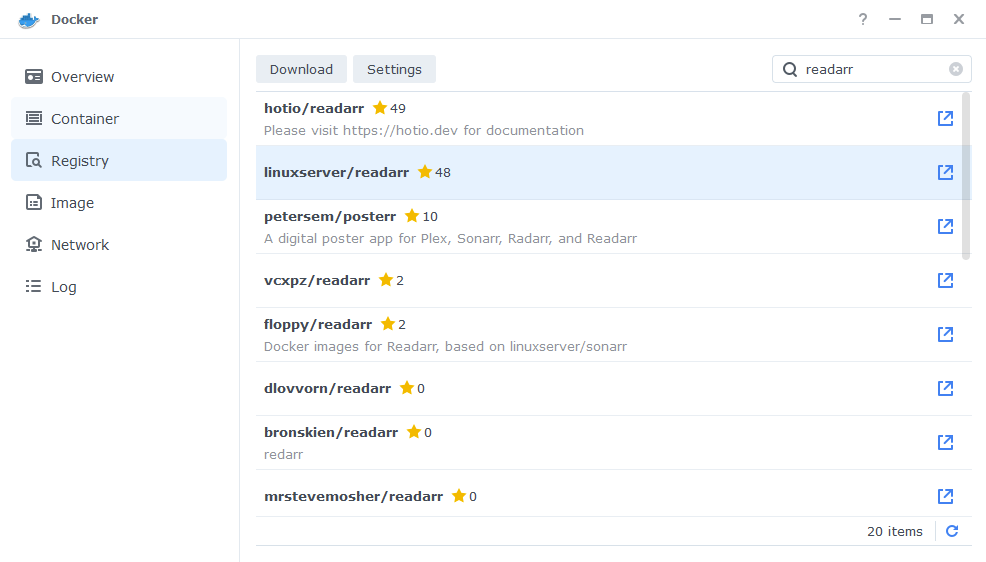
When the dialogue pops up asking you to choose a version, we are going to be using the ‘Develop’ branch as Readarr is still in development.
It can sometimes be hard to spot the correct version in the list – see the second screenshot below for it’s location

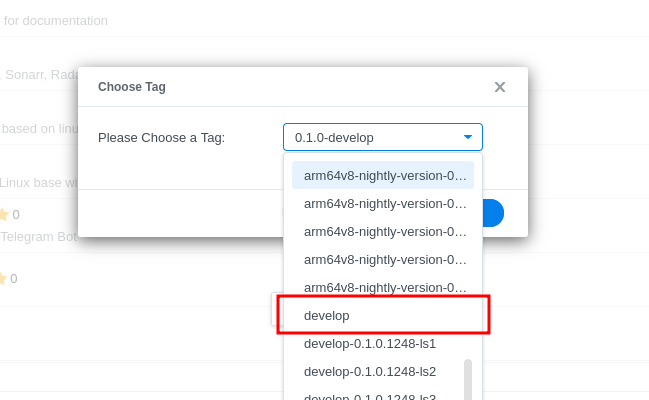
You can check the status of the download over on the ‘Image’ tab.
Setting up the container
In Docker click on the ‘Image’ tab, in the list of your containers select the ‘Linuxserver Readarr’ image and click on ‘Launch’
You will be greeted with the Network screen, we will be using the ‘synobridge’ network we created earlier select it from the list and click Next.
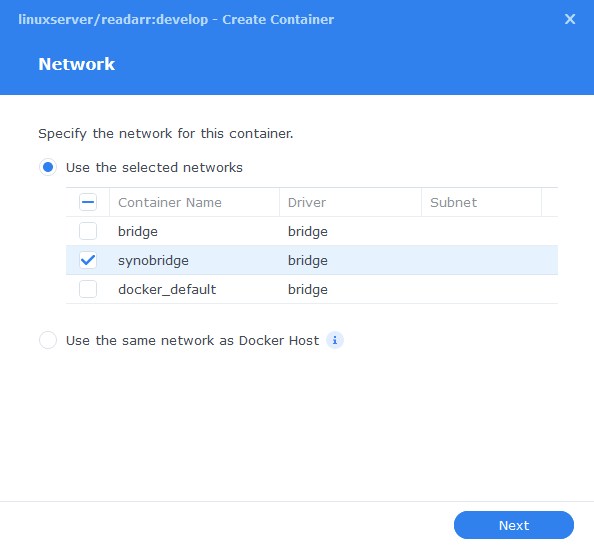
General Settings
Next you will be greeted with the General Settings screen, this is where you can start specifying some of your preferences.
You can change the name of the container to anything you like, and you may want to enable Auto Restart as this will ensure Readarr starts automatically if you reboot your NAS.
You will also notice a Configure capabilities button — don’t change anything in here!
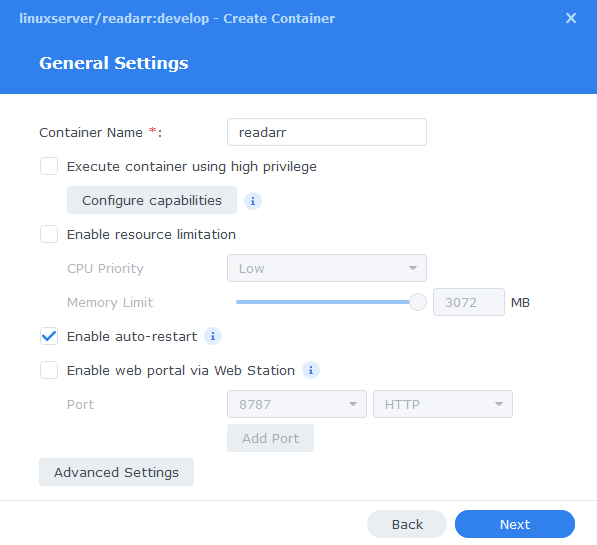
Next up we are going to click on the ‘Advanced Settings’ button, this will take you to a new window with a number of tabs which we are going to work through.
Environment (PGID, PUID and Timezone)
Next we are going to set up a couple of environment variables that docker will use to allow the container access to our files and folders and also to tell it where we live in the world.
Click the Add button, and fill in the following details as per the table/screenshot, you will need to do one at a time.
| Variable | Value |
|---|---|
| PUID | The UID you obtained in the user setup guide |
| PGID | The GID you obtained in the user setup guide |
| TZ | Your timezone wikipedia.org/wiki/List_of_tz_database_time_zones |
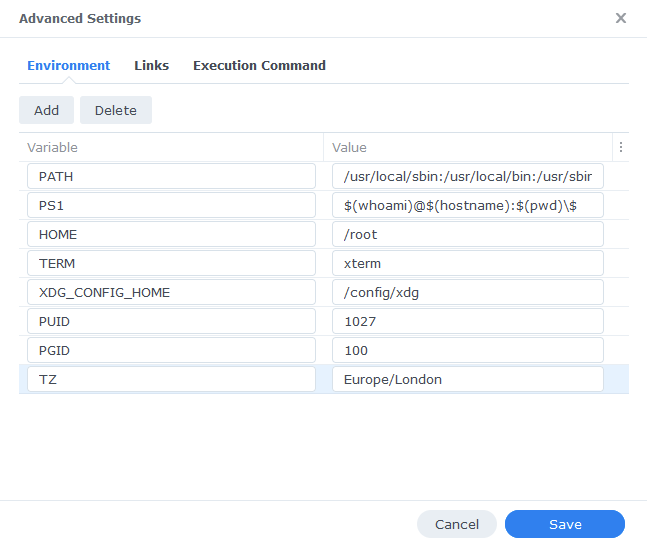
Links/Execution Commands
You do not need to set up anything on these tabs.
Press ‘Save’ to go back to the initial setup screen, then press ‘Next’
Port Settings
We won’t be changing any of the ports the container uses. You can repeat the ones shown on the right side of the settings page ‘Container Port’ onto the left side ‘Local Port’ once you have done this press ‘Next’.
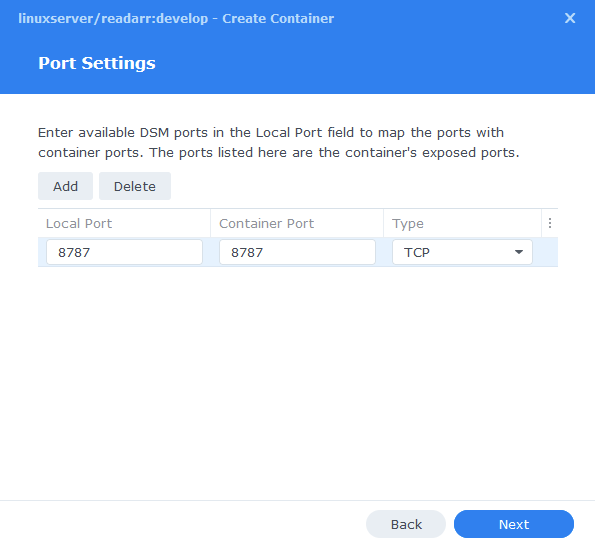
Volume Settings
We will now be specifying the directories where Readarr will store its configuration files and where to store downloaded books
Click on Add Folder, click on the docker share and create a new sub-folder called ‘readarr’ select this folder and click ‘select’
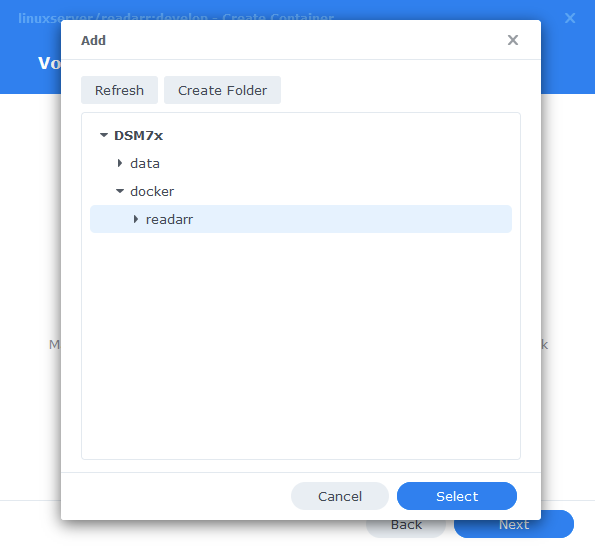
Now add ‘/config’ to the ‘Mount path’ box
Click Add Folder again and this time select the top level ‘data’ share and click Select.
You will now enter ‘/data’ into the ‘Mount path’ box
Your path settings should now look like the table/screenshot below.
| File/Folder | Mount path |
|---|---|
| docker/readarr | /config |
| data | /data |
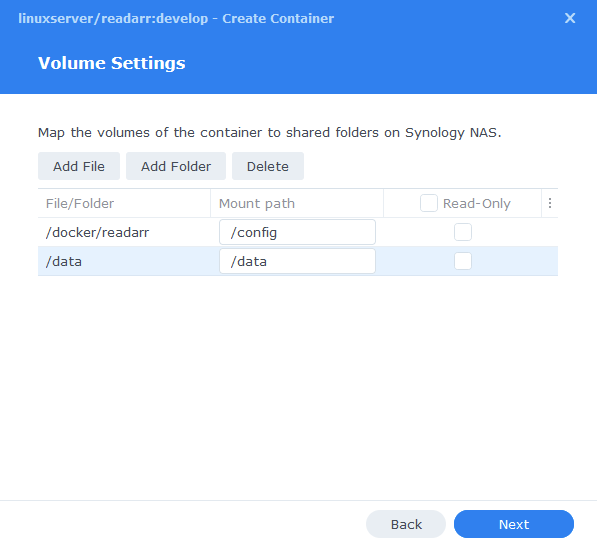
Click Next to move to the final screen.
Summary
You have now completed the setup of the container.
You will be shown an overall summary of the settings we have specified, this is a good time to double-check everything is correct. Finally, click on Done and the container should start to boot.

You should now be able to access Readarr via the IP of your NAS followed by the port 8787
e.g. 192.168.0.40:8787
Key Settings and FAQ
Now you have set up Readarr there are some key settings you will need to set as these often catch new users out. I will add more as they come up.
Media Management / Root Folders (Settings>Media Management)
Readarr refers to the place(s) you keep your Books and Audiobooks as Root Folders. These are where Readarr will ultimately move your book files once they finish downloading.
| App | Root Folder |
|---|---|
| Readarr | /data/media/books |
Download Clients (Settings > Download Clients>Remote Path Mappings)
While most of the settings on this page are self-explanatory something that has caught people out if the Remote Path Mappings setting. If you are hosting all your services on the same NAS do not add any settings here.
I can’t get Readarr to Connect to my Download Client!
When setting up your preferred download client or Prowlarr etc. Usually you will use the IP of your NAS, however if for whatever reason this is not working you can use http://172.20.0.1 which is the IP of the ‘synobridge’ gateway.
| Historic Updates | Date |
|---|---|
| New guide published | 15/07/2022 |
| Added new port settings and Docker Bridge Network | 23/07/2022 |
| Compose version number removed and small wording amendments | 09/04/2023 |
| Amended the path to save the compose file – this is for security, so the container has no access to the file contents. | 14/04/2023 |
Looking for some help, join our Discord community
If you are struggling with any steps in the guides or looking to branch out into other containers join our Discord community!
Buy me a beverage!
If you have found my site useful please consider pinging me a tip as it helps cover the cost of running things or just lets me stay hydrated. Plus 10% goes to the devs of the apps I do guides for every year.
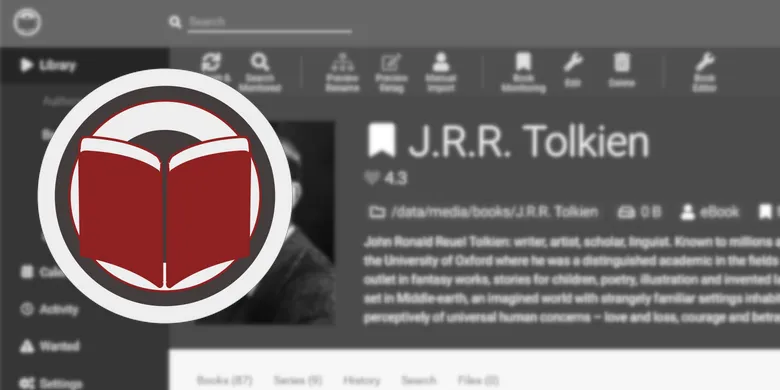



linuxserver/readarr container now has several develop options when downloading in Docker such as 0.1.0-develop, 0.1.1-develop, and so on. Couldn’t find info on the differences-any recommendation on which specific container I should download? And thanks for all the great tutorials by the way-really makes it easy to start using Docker!
Hey
It takes a bit of super slow scrolling to spot the pure :develop option without any versions on the end.
Scroll down to the bit where it has all the Develop options and then tap up on your keyboard to the top of the list – its right after the AMD64v8-nightly.
Ahhhhh! That’s what I get for being impatient-thanks so much for the insight and quick reply!